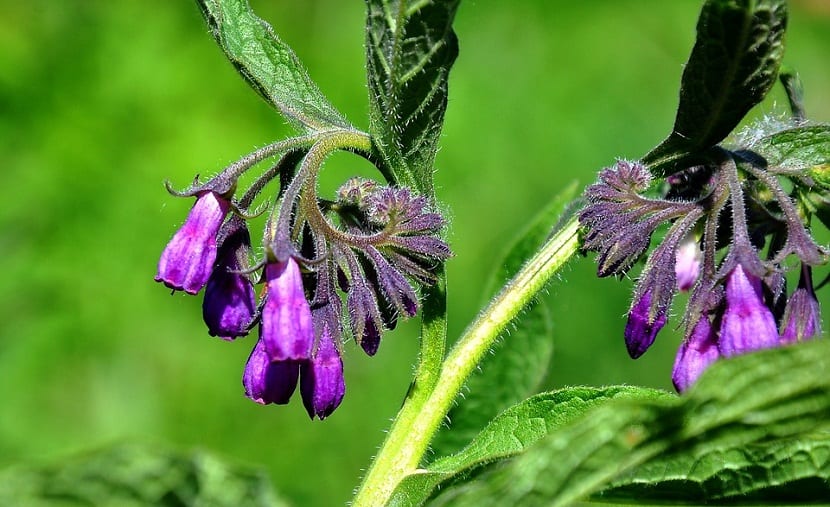
Symphytum officinale or Comfrey is originally from Europe and there are 40 registered species. It is a rhizomatous herbaceous perennial plant, of the Boraginaceae family and quite invasive.
Comfrey has been cultivated as healing herb from at least 400 BC. The Greeks and Romans used it to stop heavy bleeding, treat bronchial problems, heal wounds and broken bones.
Characteristics of Comfrey

It is a robust plant that forms a group of straight stems, with elliptical leaves up to 25 cm in length and terminal groups of tubular bell shaped flowers, in violet, pink or cream colors and two cm in length.
The species is hermaphroditic, it has male and female organs. Suitable for light (sandy), medium (silty) and heavy (clay) soils.
It has deep roots of up to two meters, which use nutrients from deep underground. The flowers provide nectar and pollen to many species of bees and other insects.
Comfrey is especially useful in the external treatment of cuts, bruises, sprains, sores, eczema, varicose veins, among others.
Contains a substance called allantoin, a cell proliferator It speeds up the healing process. This substance is currently synthesized in the pharmaceutical industry and used in healing creams.
It grows at a rapid rate up to a height of 1.2 meters. Due to its tall stature and ease of care, it is also a popular ornamental plant.
Cultivation of Comfrey
You must choose your site carefully, as comfrey can live for 20 years or more. Plant it in cool areas in the spring and in warmer areas in the wet season. Comfrey can be propagated by root cuttings, crown cuttings, or seeds.
Root cuttings are sections of lateral roots that are 5 to 15 cm long depending on the diameter. Planted horizontally 5 to 20 cm deep and will develop shoots from 20 to 40 days after sowing.
Sowing is best done in Styrofoam beds or in pots, to later be transplanted into permanent sites, when they are a year or more.
Crown cuttings are sections cut from new shoots typical of mature plants. Crown cuttings already have buds sprouted or "growing points" and should have visible top growth from 2 to 8 days after sowing. Crown cuttings are planted 7 to 15 cm deep.
Starting from the seed, it requires a winter cooling period for budding, plant them in pots in a cold frame in fall or spring. You can usually find them in herb stores or nurseries.
Comfrey is widely adapted, but will thrive in rich organic soil. As with all fast crops, you need a large amount of nitrogen. It gets all of its nitrogen from the soil, so some regular organic matter is essential.
Comfrey Care

Once established, the comfrey will take care of itself. Every year the plant will grow a little and the root system will become more dense. An established plant is very difficult to get rid of, and it can live for several decades before it begins to decline.
It is very drought tolerantHowever, regular watering will keep it growing strong and blooming. Remove flower stalks in the first season for maximum leaf growth next year.
Comfrey Harvest
The leaves can be harvested and dried at any time. If you are growing it to harvest the leaves, you can make your first cut when the plants measure approximately 0,6 meters. Wear gloves, as the stems are covered in stiff hairs that can irritate the skin.
You can cut them throughout the season, but not after September, this will allow for a final fall growth before winter. The leaves can be used in three different ways, as a liquid feed, as a compost activator or directly in or on the soil as a fertilizer for plants.
Genial!
Thank you very much, Lola. We're glad you liked it.
If I mix the leaves, previously shredded, green or dried with the vegetable waste and incorporate them into the compost, will the comfrey act as an activator of the compost as if it were purin? I wait for an answer.